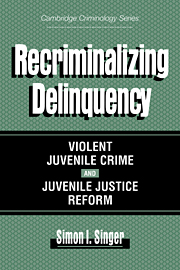Book contents
- Frontmatter
- Contents
- List of Figures and Tables
- Acknowledgments
- Introduction
- 1 Recriminalizing Violent Juvenile Crime
- 2 Taking Stock of Juvenile Justice Reforms
- 3 Recriminalization on the Move and Its Legal Rules
- 4 Contextual and Legal Reasons for Identifying Juveniles as Criminal Offenders
- 5 The Case Processing of Juvenile Offenders: From Arrest to Disposition
- 6 Recriminalization and Organizing for Deterrence
- 7 Convicted Juvenile Offenders in a Maximum Security Institution
- 8 Concluding “Real” Reasons for Recriminalizing Delinquency
- Appendixes
- Notes
- References
- Index
6 - Recriminalization and Organizing for Deterrence
Published online by Cambridge University Press: 29 September 2009
- Frontmatter
- Contents
- List of Figures and Tables
- Acknowledgments
- Introduction
- 1 Recriminalizing Violent Juvenile Crime
- 2 Taking Stock of Juvenile Justice Reforms
- 3 Recriminalization on the Move and Its Legal Rules
- 4 Contextual and Legal Reasons for Identifying Juveniles as Criminal Offenders
- 5 The Case Processing of Juvenile Offenders: From Arrest to Disposition
- 6 Recriminalization and Organizing for Deterrence
- 7 Convicted Juvenile Offenders in a Maximum Security Institution
- 8 Concluding “Real” Reasons for Recriminalizing Delinquency
- Appendixes
- Notes
- References
- Index
Summary
there is a bottom-line question that policy makers often ask when considering legislative waiver. It is the question of deterrence and whether legislative waiver affects the rate of juvenile crime. In New York State, the question can be asked specifically in terms of the JO law. Did it actually lower the rate of violent juvenile crime? Recall from the legislative debates the comment of Assemblyman Koppell in support of passage of the JO law:
Meting out measured punishment is something that will, in fact, deter… Every time a young person reads he committed murder and he is subject to a mandatory sentence of 18 months, that says to that unsophisticated mind, “Well, it couldn't be very bad. All it was is 18 months.” … The law must say to that person, yes, this is very bad (125).
But, as detailed in the previous chapter, charged juvenile offenders may discover that the risks of criminal punishment are relatively low, especially for less than the most serious violent offenses. They may discover that the JO law is more bark than bite as a result of their experiences in the criminal justice system.
Yet in its simplest form, a theory of criminal deterrence proposes that it is the threat of legal punishment that will prevent criminal behavior. Deterrence theory takes on a general form when it refers to the impact of the threat of punishment on everyone in a particular group, such as persons between 13 and 16.
- Type
- Chapter
- Information
- Recriminalizing DelinquencyViolent Juvenile Crime and Juvenile Justice Reform, pp. 152 - 164Publisher: Cambridge University PressPrint publication year: 1996

